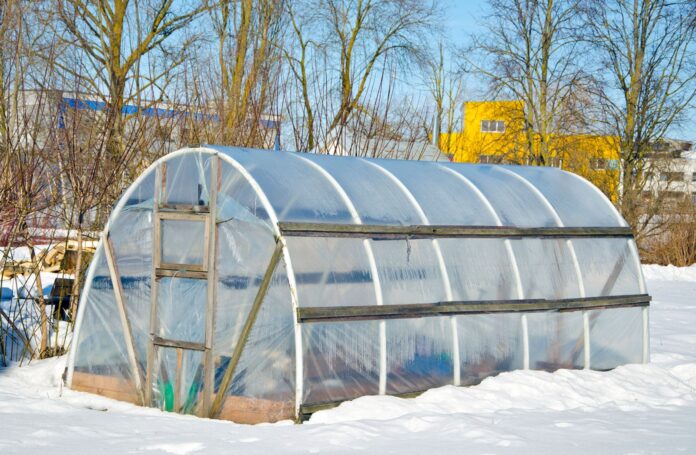When winter’s chill sets in, roses in your home gardens face a tough time dealing with frost, strong winds, and harsh weather. Commercial growers with high-tech greenhouses can control the environment easily, but it’s a different story for those of your gardening at home. Imagine, a 10,000-square-foot climate-controlled greenhouse can cost between $200,000 and $300,000. That’s way out of reach for most families. So, you need cheaper, doable ways to keep your beloved roses safe through winter.
In this guide, we give some handy, budget-friendly tips to protect your roses during winter. Now, let’s explore the below strategies to keep your roses thriving even when cold outside.
Move Pots Indoors or to Wind-Sheltered Areas
One smart move is bringing potted roses inside or to places where the wind can’t hit them hard. This works best when winters are really cold or windy. Take your roses inside your home or garage. This way, they stay safe from freezing temperatures, frost, and gusty winds.
Pick spots inside with plenty of light, like near windows, so your roses get the sunlight they crave. But be careful not to put them where it’s too hot or stuffy, as this might kickstart growth too soon or lead to bugs.
Can’t bring your pots inside? Find a spot outside that’s shielded from the wind. Tuck them near buildings or behind screens to reduce the chill and wind. These steps can really boost your roses’ chances of making it through winter, ready to bloom in spring.
Water Right, Keep the Soil Just Moist

Winter watering is all about balance. In winter, roses don’t drink as much as they do when they’re growing. With heating indoors and cold air outside, soil dries out faster. Watering too much can lead to soggy roots and other water troubles, especially inside. Therefore, you should adjust your watering based on how warm your house is, what kind of soil you have, and what your roses are like.
A good rule is to water when the top of the soil feels dry. You want to avoid keeping the soil wet all the time. Well-draining soil is your friend here, helping keep moisture levels just right. Outdoors: if your roses are sheltered or under something, they won’t dry out as fast. So, watch how much you water. Keep an eye on your plants and check the soil to ensure it’s moist but not soggy, perfect for winter.
Prune with Care
Pruning in winter is about timing and technique. Get rid of weak, dead, or too-dense branches. This lightens the load on your roses, making them less likely to struggle under snow or wind. Pruning also helps air move better, and light gets through, which can stop diseases. The best time for this is early winter or late fall, but don’t prune when it’s super cold – that can harm the fresh cuts.
Always use sharp, clean tools to prune. This gives you neat cuts and keeps diseases away. For climbers or big rose bushes, pruning helps keep their shape and support. In short, winter pruning clears out problem branches and sets the stage for healthy growth when spring rolls around.
Root Covering

To protect your roses’ roots from cold and frost, cover them up. Use leaves, pine needles, straw, or gardening blankets. Lay these gently around the roots, a few inches thick, suited to your local weather.
This covering acts like a cozy blanket, keeping soil moisture in and cold air out. These materials naturally break down, adding nutrients to the soil come spring. Just be sure to remove the cover when it warms up to prevent too much dampness or bugs. This simple step boosts your roses’ chances in winter, preparing them for a vibrant spring.
Wind Barriers
Dealing with strong winter winds? Setting up wind barriers is smart if your roses aren’t in pots but in your garden. Use natural barriers like dense bushes or tall trees, or go for fences or wind nets. Ensure your barrier is tall enough to protect your roses and set up to block the main wind direction.
Leave some open spots for air to flow through. This stops the area from getting too damp, which can cause diseases. And remember, don’t block the sunlight. Good wind barriers help your roses survive harsh winds, keeping them healthy for springtime.
Portable Greenhouses or Covering

For roses spread across a big garden, consider using group covering methods, like portable greenhouses, for winter protection. You can also use gardening cloths or specialized farm covers, such as non-woven fabric or breathable plastic. These materials envelop the entire rose area, effectively maintaining soil warmth and moisture, shielding against frost, and reducing harm from chilly winds.
Begin by clearing the ground of weeds and old plants to deter pests. Then, lay out and secure your covering, whether it’s portable greenhouses or other materials, ensuring it stays in place and won’t be carried away by the wind. As spring approaches and temperatures rise, remove the cover to allow your roses to grow naturally. This type of group covering, especially using portable greenhouses, is an efficient solution for large rose gardens, minimizing winter maintenance while preparing for a flourishing spring.
Knowledge: What Temperature Will Kill Roses in Your Garden?
Roses, being quite resilient, can generally withstand cold temperatures. However, extreme cold, particularly temperatures that drop below 20°F (-6.7°C), can harm roses, especially if these low temperatures persist for a prolonged period.
Most modern hybrid roses and tea roses are less hardy and may require protection if temperatures drop below freezing (32°F or 0°C), while many shrub and old garden roses can tolerate colder conditions. It’s also important to note that sudden temperature fluctuations can be more damaging than a consistent cold temperature.
Conclusion
Even without fancy greenhouses, you can keep our roses safe in many ways. From bringing pots indoors to making wind barriers and group covers in the garden, each method works wonders in its own way. It’s not just about getting 6 Essential Tips for Protecting Your Roses in Cold Winter







